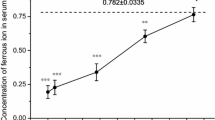Summary
A spectrophotometric technique for the identification of irradiated chicken (gallus domesticus) and doses ranging between 0.1 and 2.5 Mrad is described. Spectrophotometric determination of the sulfhydryl content in the animal tissue before (control) and after using 6,6′-Dithiodinicotinic acid is applied.
Ionizing radiation causes a permant loss of sulfhydryl groups in the animal tissus such as chicken. Irradiation at room temperature and storing at −18 °C over a period of approximately one month does not show restitution or repair of the sulfhydryl loss. The dose-effect relation for this radiation-induced decrease of the sulfhydryl content can be described best by a double exponential function.
Irradiation conditions, preparation of protein suspension from chicken, spectrometric investigations and other experimental details are reported. The results of all will be discussed in detail.
Zusammenfassung
Es wird eine spektrometrische Technik für die Identifikation von bestrahltem Geflügelfleisch(gallus domesticus) und Strahlendosen zwischen 0,1 und 2,5 Mrad beschrieben. Die spektrophotometrische Bestimmung des Sulfhydrylgehaltes in dem tierischen Gewebe vor (Kontrolle) und nach der Bestrahlung wird mit Hilfe von 6,6′-Dithiodinikotinsäure durchgeführt.
Ionisierende Strahlung verursacht einen bleibenden Verlust von Sulfhydrylgruppen in tierischen Geweben wie Geflügelfleisch. Die Bestrahlung bei Zimmertemperatur und Lagerung bei −18 °C über einen Zeitraum von ungefähr einen Monat läßt keine Wiederherstellung bzw. Reparatur des Sulfhydrylgruppenverlustes erkennen. Die Dosis-Effekt-Beziehung für diesen strahleninduzierten Abbau des Sulfhydrylgehaltes kann am besten durch eine doppelte Exponentialfunktion beschrieben werden. Über die Bestrahlungsbedingungen, die Herstellung von Proteinsuspensionen aus Geflügelfleisch, die spektrophotometrischen Bestimmungen und andere experimentelle Details wird berichtet. Die Ergebnisse werden im Detail diskutiert.
Similar content being viewed by others
Literatur
Diehl, J. F.: Kerntechnik19, 494 (1978)
Diehl, J. F.: Ernährungswissenschaft Suppl.16, 111 (1973)
Stockhausen, K.: Atomkernenergie24, 51 (1974)
Stockhausen, K., Weise, H.-P.: Atomkernenergie27, 213 (1976)
Stockhausen, K., Bögl, W., Jahn, M., Weise, H.-P.: Starch/Stärke30, 1 (1978)
Stockhausen, K., Bögl, W.: The level of sulfhydryl groups as an indicator of radiation treatment of meat. Vortrag: IAEA-SM-221/19 auf Symposium über Lebensmittelbestrahlung, Wageningen/Netherlands, 1977 wird veröffentlicht in: Food Preservation by Irradiation. Proceedings of a Symposium, abgehalten in Wageningen/Netherlands, 1977, Vol. I, p. 421. Vienna: IAEA 1978
Stockhausen, K.,Bögl, W., Censori, M., Jahn, M., Sander, B.: Sulfhydrylgruppengehalt als Indikator der Strahlenbehandlung von zum Verzehr bestimmtem Fleisch und Fisch. Strahlenhygiene-Ber. Nr. 19/77 (1977)
Stockhausen, K., Bögl, W., Weise, H.-P.: Atomkernenergie31, 184 (1978)
Fricke, H., Hart, E.J.: Chemical dosimetry. In: Radiation dosimetry. Attix, F. H., Roesch, W. C. (eds.), p. 167. New York: Academic Press 1968
Merishi, J.N., Grassetti, D.R.: Nature224, 563 (1969)
Sutherland, R. M., Pihl, A.: Radiat. Res.34, 300 (1968)
Rothfield, L., Romeo, D.: Enzyme reactions in biological membranes. In: Structures and function of biological membranes. Rothfield, L. (ed.), p. 253. New York: Academic Press 1971
Kreyszig, E.: Statistische Methoden und ihre Anwendungen. Göttingen: Vandershoeck und Ruprecht 1974
Hug, O., Kellerer, A. M.: StochastikderStrahlenwirkungen. Berlin, Heidelberg, New York: Springer 1966
Myers, D. K., Bide, R. W.: Radiat. Res.27, 250 (1966)
Friedman, M.: The chemistry and biochemistry of the sulfhydryl groups in amino acids, peptides, and proteins, Chap. 10, 258. Friedman, M. (ed.). Oxford, New York, Toronto, Sydney, Braunschweig: Pergamon Press 1973
Author information
Authors and Affiliations
Rights and permissions
About this article
Cite this article
Stockhausen, K., Bögl, W. & Weise, HP. Nachweis der Strahlenbehandlung bei bestrahltem Geflügelfleisch anhand des strahleninduzierten Verlustes von Proteinsulfhydrylgruppen. Z Lebensm Unters Forch 167, 256–261 (1978). https://doi.org/10.1007/BF01135599
Received:
Issue Date:
DOI: https://doi.org/10.1007/BF01135599



